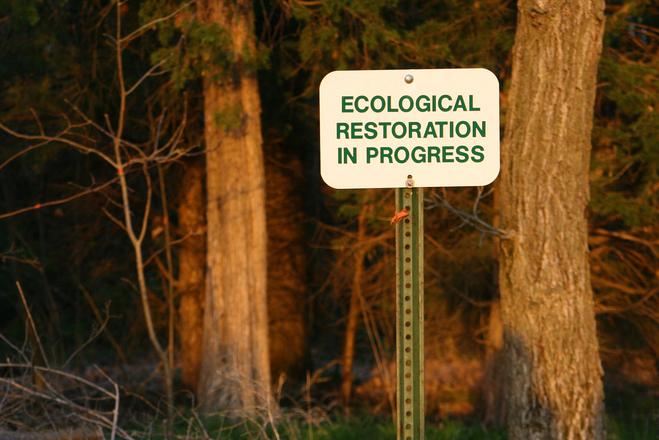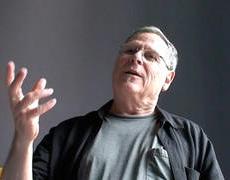At first glance, the intent of ecological restoration may appear obvious: repair some of the damage humans have done to ecosystems and biodiversity. But a closer look reveals the complexity inherent in designing and carrying out a restoration plan—activities that necessarily engage a wide diversity of scientific, legislative, regulatory, and planning expertise.
Many of the world’s ecosystems have been altered, degraded, or entirely destroyed by human activities, and the negative impacts of transformed landscapes can have far-reaching consequences for natural and social systems alike. Intense urbanization, for example, can devastate the natural habitat of a species, driving it to local or global extinction. Researchers have found that one extinction can lead to another. These major ecological disruptions can ripple though interlinked ecosystems to impact human well-being.
Although it’s widely acknowledged that human intervention through ecological restoration is necessary to correct, enhance, remediate, or [insert-your-restorative-verb-here] these altered landscapes, exactly what such intervention should entail is still much debated. Notions of restoration range from the romantic to the bureaucratic. Restorationists may struggle to resolve the perhaps irreconcilable goals of returning a landscape to what it once was while producing benefits for the natural environment and the people who depend upon it. Regulatory requirements, technical limitations, and fiscal constraints can fundamentally influence the objectives and implementation of a project.

Above photo courtesy Quinn Dombrowski via Flickr/Creative Commons
Suddenly, what restoration looks like and how it should be done is far less intuitive.
Cue: Baird Callicott, University Distinguished Research Professor of Philosophy at the University of North Texas. As a SESYNC Sabbatical Fellow in the fall of 2014, he led an interdisciplinary synthesis group tasked with integrating philosophical, ecological, legal, economic, and ethical perspectives to explore the implications of using an ecosystem services approach to ecological restoration. The group was motivated by two questions underlying the restoration debate:
Should we frame restoration projects to replicate the historical community—i.e., rebuild the living and structural components of the “original” landscape? Or should we frame restoration projects to recondition ecological processes and functions—e.g., repair an ecosystem’s capacity to regulate nutrients or disturbances irrespective of whether the restored components were present in the historical landscape?
The following Q&As merely hint at the diversity of perspectives engaged in this synthesis group, but they begin to shed light on why “restoration” can mean different things to different people. Dr. Callicott points to one particular example of “cognitive dissonance,” as he calls it, that emerged during the project meetings:
“I conceive of restoration in terms of a long historical trajectory: how it was originally conceived in the 1930s, and how the concept has evolved over time,” he said. “Others may conceive of restoration as a relatively new field that’s only been around for 25 years. That dissonance can be explained in part by whether you approach the conversation through the lens of ecological restoration—the practice of restoring—or restoration ecology—the science that informs the practice.”
Despite their epistemological differences, however, the group participants rallied around shared ideas that resulted in several submitted papers. Non-spoiler: check back to www.sesync.org for publication updates from the group!
Baird Callicott, Environmental Philosopher & SESYNC Sabbatical Fellow

What are the benefits and limitations of classic restoration, i.e., restoring for historical community?
I see classic restoration as having multiple benefits—the most important of which, in my opinion, being cultural value. It involves people in community efforts, connects them with a historical landscape, and provides a sense of place.
Take, for example, the University of Wisconsin Arboretum, which is in some sense the birthplace of ecological restoration. It was theorized by Aldo Leopold, the great Wisconsin conservationist, who wanted to recreate a sample of what he called “Old Wisconsin.” For him, it was not really in order to get back to anything. It was about having a baseline of ecological processes and functions in order to measure the modern changes people were making on the landscape. So, this was a scientific research project. But in subsequent generations, especially at the community level, it became a project for fun—a very sophisticated kind of fun where people are doing something in a creative way for which they get a lot of personal and community satisfaction.
The Arboretum also demonstrates the limitations of classic restoration—the project has been institutionally supported for 80 years, and it’s still not successful. The Curtis Prairie is persistently invaded by exotic species. The city has used it as a stormwater runoff retention area, so gullies are running through the famous prairie. Some of my colleagues at the University of Wisconsin say that once land is plowed and the sod is turned over, the subsoil microbial community is basically altered in such a way that you can never get the prairie back to what it was. So in some ways, it’s a futile project.
What are the benefits and limitations of restoring for ecological processes and functions?
I think it’s a lot easier to restore processes and functions than it is to restore historical biotic communities because, in many cases, the changes have been so profound or even irreversible. For example, you might be able to recover the process of hydrological regulation and purification, but with non-native species.
As a philosopher, I’m a little skeptical of the term “ecosystem functions.” I think that from the point of view of the organisms we say are carrying out the functions, they’re just doing their thing. Let’s put it this way: they don’t regard themselves as carrying out functions. The function of earthworms is to process detritus and aerate the soil, but what they’re doing is just getting their dinner for the day. So when we talk about ecosystem functions, it’s to some extent already beginning to bleed conceptually into ecosystem services. The line between those two concepts is a bit blurry. Function is something we are looking at from an external point of view, not from the point of view of the organisms themselves.
What does effective restoration “look” like to you? How is it done, and what does it accomplish?
Effective restoration, to me, is about process, not composition. It accomplishes whatever goals defined for the project—whether they be in terms of soil quality, water retention and purification, and so on—by whichever organisms are able to effectively carry out those processes, regardless of their species identity or whether they are native or non-native.
Frankly, as a philosopher, I think that the distinction between native and non-native species becomes a conceptual quagmire in many ways. The example that I like to use is the genus Equus in North America. It evolved in North America but, about 10,000–11,000 years ago, horses suddenly disappeared from the continent. The suspicion is that they were rendered regionally extinct by the invasion of Siberian big game hunters who populated the continent. Then the horse came back to North America with the Spanish in the 15th century, got loose, and reestablished itself as a wild species. So, is Equus native or non-native? If by native you mean where it evolved, then it’s native. If by non-native you mean it got here by human means, then it’s non-native. It becomes very difficult to sort these things out.
What role does restoration play in your research?
One of the things I’ve learned during my time at SESYNC is that I’m a dabbler in comparison with many of the people in the project. Restoration is a sub-theme in my broader research agenda, which has recently involved comparative environmental ethics, climate ethics, and the philosophy of conservation biology and ecology.
Matthew LaFevor, Human Geographer & SESYNC Postdoctoral Fellow

What are the benefits and limitations of classic restoration, i.e., restoring for historical community?
One of the limitations of classic restoration is that it has too often relied on a sense of nostalgia for the past. The idea of “the pristine myth”—that the biophysical environment was in a pristine state before the arrival of Europeans—and its corollary, “the green myth”—that indigenous peoples lived in harmony with their environments and were ideal ecologists—pervades the American sense of ecosystem restoration. So, there’s a general notion that restoring past environments is inherently a good thing.
But the pristine and green myths have been debunked through paleo-environmental research. Environments were sometimes better and sometimes worse. Societies practiced both good and bad stewardship of these environments. It depends on where and when. Many environments were already degraded when Europeans arrived; the past wasn’t always better. And when you consider the assumptions under which classic restoration is actually practiced, selecting appropriate historical targets for restoration becomes problematic or even controversial. I approach this as a human geographer who’s worked a lot with archeologists, paleo-ecologists, geo-archeologists, environmental historians, etc. We really don’t know a lot about many past environments, their precise compositions, or whether they actually functioned better during a certain time period. Historical continuity in ecological restoration is a fascinating and complicated topic that lends itself to cross-disciplinary research.
What are the benefits and limitations of restoring for ecological processes and functions?
Restoration ecology widely acknowledges that, in the past, we’ve focused too much on replicating the analogues or archetypes of the structural elements of landscapes. Restoring instead for processes and functions, rather than structures, can achieve multiple benefits, including greater ecological integrity.
Process-based restoration of ecosystems can be difficult, though, in part because restoration has unfortunately tended to focus on restoring one ecosystem service at a time. To be more effective (and beneficial), we should focus instead on restoring ecosystem functions to make restoration a sustainable, self-supporting process.
What does effective restoration “look” like to you? How is it done, and what does it accomplish?
In practice, that would depend on the specific goals of the restoration project and for whom you are restoring. Are we restoring for the public, academics, politicians, nature’s own sake, or human communities who need basic ecosystem services to survive? “Effective” would signal that functional goals were met; so, it depends on the initial goals. I can’t answer this question generally because I view each individual restoration project as a unique effort. Our SESYNC group has outlined four basic criteria that should be met in each case, however. The paper is under review.
What role does restoration play in your research?
I am interested in using the theories and methods of restoration ecology to restore agro-ecological systems. It’s important because about 40% of the surface of the Earth is covered with farmland or land that was at one time cultivated. Much farmland is degraded and in need of restoration—most of it will not be reconverted to a “natural” environment. When we talk about ecological restoration in the strictest sense, we’re talking about the restoration of natural ecosystems—ecosystems that are resilient and can sustain themselves without human involvement, eventually. In reality, that’s only a fraction of the Earth’s surface. It also constitutes only a fraction of the ecosystem services provided by the biophysical environment. Agricultural landscapes are the primary medium through which many societies receive critical environmental or ecosystem services, such as clean water, soils, and air. And although they are artificially structured, agro-ecological systems incorporate many elements of natural ecosystems, again, depending on where they are, the strains of crops grown, and the degree of human involvement and manipulation of the biophysical environment (intensity), among other factors.
So, I am fascinated by how we can use the theories and methods of restoration ecology in the context of agro-ecological restoration. Not because I think this is the same as ecological restoration, but because the two fields have much to learn from each other. Ecological restoration incorporates many of the technologies of intensive agriculture into its programs of environmental repair. In turn, agro-ecological system (re)development can often benefit from the theories and methods used in restoration ecology. Restoration ecology can help agriculture engage in more sustainable and ecologically diverse ways of producing food. Some of these methods have been around for thousands of years; many have been forgotten; others are currently evolving along with new technologies and scientific discoveries. Bridging the two broad disciplines of conservation and agronomy is an important theme in my own research, especially as these relate to landforms and hillslope processes. Being involved with the Restoring Services or Ecosystems group helped me expand my own disciplinary horizons, and it has provided me many insights and ideas to explore in the future.
Margaret Palmer, Restoration Ecologist & SESYNC Executive Director

What are the benefits and limitations of classic restoration, i.e., restoring for historical community?
Classic restoration is not always possible because so many things have changed in the environment, so the conditions often won’t support what was there previously. That doesn’t mean that information about the historical condition and community isn’t critical to designing a restoration project and knowing what will work. The role of history is critical in restoration, but it’s not necessarily your reference target that you direct your project towards.
What are the benefits and limitations of restoring for ecological processes and functions?
First of all, restoring for processes and functions can be the same as classic ecological restoration, but doesn’t have to be. The primary concerns with this approach are that the focus is often on one or several processes and functions, and not the full suite—that is, a project may seek to maximize one service at the exclusion of others.
One of the reasons it’s a potential problem is that you can make decisions locally that can have implications at distances from that site. And those implications will vary depending upon the distance away from the restoration site, what kind of system you’re in, and how local processes influence regional processes. Certainly in river networks, it’s a huge issue. For example, let’s say you want to maximize the service of water for agriculture, which happens all the time in various regions around the world. So you’re pulling water out of a natural network and moving it into fields for production; that means less water for downstream folks.
What does effective restoration “look” like to you? How is it done, and what does it accomplish?
There are several fundamental conditions necessary for an ecological restoration project. It has to be designed with the intent to restore either the historical or contemporary assemblages of plants and animals that are in reference sites of the same type that you’re focusing on. It has to seek to restore those processes of similar reference sites. It has to be self-sustaining. And finally, it has to not do any net harm to the system. That’s a lot of conditions, which means a lot of things people are calling restoration now are actually not restoration. They may be very valuable to people, but they are not the same thing as ecological restoration.
What role does restoration play in your research?
My whole research agenda is focused on restoration—specifically, trying to understand how you restore streams and rivers effectively given that so much of the landscape has been changed and is degraded. Streams and rivers basically integrate everything that’s been done on the land, so if you’ve changed the land a lot, it becomes very difficult to move the stream or river system to some historical or contemporary reference condition.
When I talk about restoration requiring that you design the project to move towards historical or contemporary conditions, note that I say “design.” I didn’t say it actually becomes that historical or contemporary reference condition because, often, it can’t. But at least the attempt has to be to move it in that direction as far as possible. A lot of my work right now is really thinking about disentangling those—i.e., designing and doing—as well as understanding how restoration is being used for other purposes and how we can provide information to managers that will help them make decisions about, for example, whether or not they should permit activities that result in ecosystem degradation and, therefore, necessitate “corrective” restoration.
Further Reading
Eric Higgs. (2003). Nature by Design: People, Natural Process, and Ecological Restoration. The MIT Press.
William R. Jordan III, Michael E. Gilpin, & John D. Aber. (Eds.). (1990). Restoration Ecology: A Synthetic Approach to Ecological Research. Cambridge University Press.